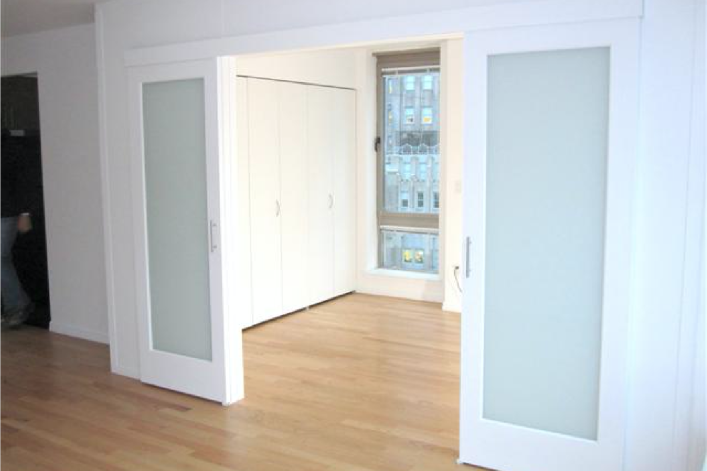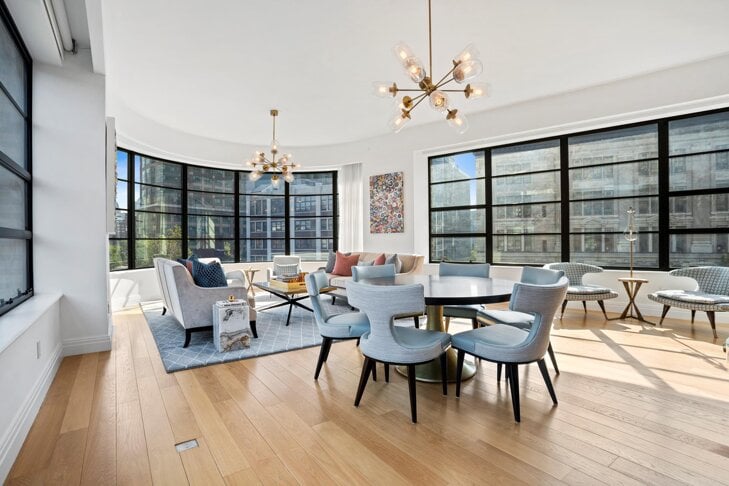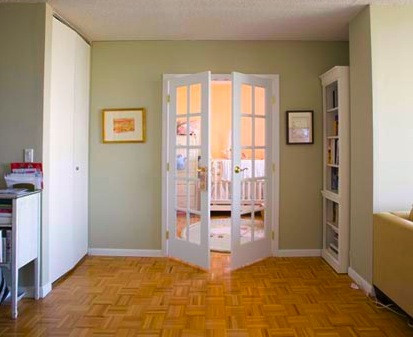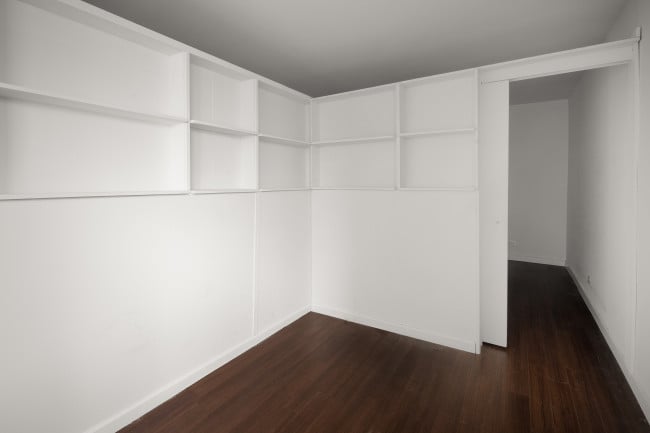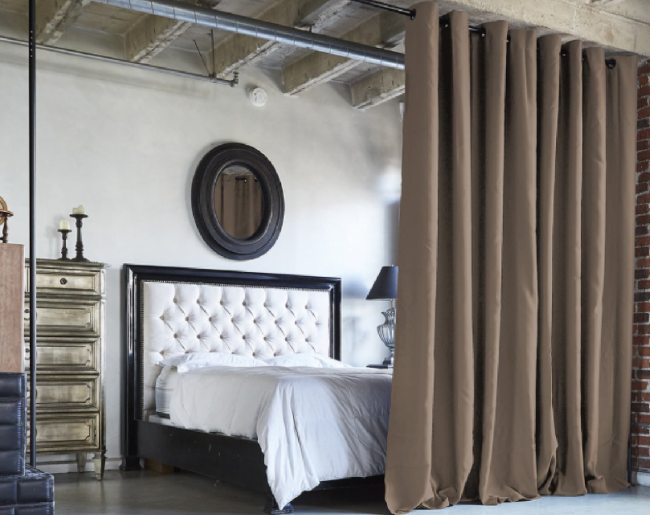These 18 New York City landlords allow temporary walls
Walls may not talk, but if they could they would tell you lots of secrets about living in New York City. Here’s one: Some walls are fake, and for many people, that makes all the difference in being able to afford their dream of living in New York City.
With the median rent of a Manhattan apartment now $3,290, according to Douglas Elliman, apartments in New York City are out of range for many people, especially students or those starting their careers. However, by installing a temporary, or flexible wall, you can "flex" a one bedroom into a two, or a two bedroom into a three or even four, enabling that hefty rent to be split among roommates.
[Editor's note: An earlier version of this post was published in August 2018. We are presenting it again here as part of our winter Best of Brick week.]
But before you install anything, knowing the different kinds of walls and what your landlord permits is key. Brick Underground spoke to brokers to identify which building management companies allow temporary walls and what kinds. Here's what they had to say.
Types of temporary walls
One example of a flexible wall that’s easy to create the semblance of a room is a piece of furniture, like these bookshelf walls or an unattached partition. Acoustic curtains—manufactured to absorb sounds—are another temporary option that you can install and then take with you when you move.
A more substantial—and popular—solution is a pressurized wall that has a 6- or 12-inch opening between the top of the wall and the ceiling, for natural light and ventilation. Some landlords think because a temporary wall has gap they don’t need to go through the Department of Buildings. However, while temporary walls aren’t covered specifically in the building code, according to a DOB spokesperson, renters should follow the same rules for a permanent wall. Any new wall that changes an apartment layout, whether floor-to-ceiling or with a gap at the top, is supposed to have a DOB permit, even if it is temporary.
“Sometimes it has a sliding door with a latch without a doorknob. Sometimes you’re not allowed to have a door at all, just an area to walk through,” says Steve Markowicz, an agent with CORE. “It depends on the landlord and their interpretation of the fire code.”
Finally, there’s the full-sized pressurized wall, from floor to ceiling and with a door. But because these constitute a change to the apartment’s layout, these also require approval from the Buildings Department. What each type has in common is they do not attach to existing floors, walls and ceilings, and can be easily removed without causing damage. Naturally, not all apartments are conducive to this option, and some landlords don’t allow flex walls—especially since the city started to crack down on them in 2010 in the interest of fire safety.
What are the rules?
But many landlords still do. What’s key is to get permission first from management if you want a temporary wall, and find out what the rules are for installation, because they often vary from company to company.
“Don’t just assume you can flex. If a wall is not built to code and management finds out, you can get it ripped down and that’s money just lost,” says Joshua Juneau, an agent at Triplemint (FYI, a Brick Underground partner).
Most buildings will have their preferred contractor or company install walls for the building. “A few landlords will allow any company to come in so long as they have a certificate of insurance,” says Michael Jeneralczuk, an agent with The Undorm Team at Citi Habitats, which specializes in finding apartments for students and recent graduates.
Several companies in New York specialize in installing these dividers, and prices can range from around $700 to $2,000 or more. The tenant is responsible for the cost and for having the wall removed when they vacate the space.
“The landlord tells you what kind of wall can be put up, but it has to be removed, and the super will inspect it before returning the security deposit,” Markowicz says.
Occasionally, a landlord will allow a wall to remain after a tenant leaves because it might be easier to rent the space with the wall already up.
When looking at listings, the words “convertible” or “flexible” are often clues that room dividers are allowed. Flexible units are often found in doorman buildings with larger one- and two-bedroom apartments, says Juneau. Neighborhoods where there’s a fair share of such buildings are Murray Hill, Midtown East, Kips Bay and Midtown West/Hell’s Kitchen, according to multiple agents.

Brick Underground's
Gross Rent Calculator
What's this?
Some New York City landlords offer a free month (or more) at the beginning or end of a lease. The advertised rent is the net effective rent. The net effective rent is less than the amount you will actually have to pay --- known as your gross rent --- during your non-free months.
Brick Underground's Gross Rent Calculator enables you to easily calculate your gross rent, make quick apples-to-apples comparisons between apartments and avoid expensive surprises. All you'll need to figure out your gross rent is 1) the net effective rent, 2) the length of your lease, and 3) how many free months your landlord is offering. [Hint: Bookmark this page for easy reference!]
To learn more about net effective versus gross rents, read What does 'net effective rent' mean?.
If the landlord is offering partial months free, enter it with a decimal point. For example, 6 weeks free rent should be entered as 1.5 months.
Building management companies that allow temporary walls
Avalon was identified by Triplemint’s Juneau as allowing temporary walls, but did not respond to requests for confirmation.
BLDG Management has some buildings that allow temporary walls, but the rules vary from building to building. For the Montana at 247 West 87th St., pressurized walls that are not nailed into the ceiling, floors or walls are allowed. They can go up to the ceiling, but they generally don’t, says a company spokesperson. Tenants can use the wall company of their choosing, as long as the company provides insurance. The wall must be removed upon vacancy.
Broad Street Development allows flex walls, but they must be 12-inches from the ceiling. Property manager Samantha Santos says they’ve worked with Manhattan Pressurized Walls, but tenants can use any company, as long as they have the correct insurance.
To rent an apartment in New York City, most landlords require you (or you and your roommates combined) to earn an annual salary of at least 40 to 45 times the monthly rent. If you don't—or if you’re an international employed person, self-employed, non-employed with assets, retired, or an international student or US student—you’ll need to find a guarantor for your lease who earns at least 80 times the monthly rent and lives in New York, New Jersey or Connecticut. Or you can turn to Insurent Lease Guaranty. Accepted at more than 4,700 buildings across the city representing over 475,000 apartments, Insurent Lease Guaranty is a quick and easy way to get the apartment you want. Click here to learn more.
Brodsky Organization does not allow walls, but does allow room dividers, such as bookcases or other furniture that can act as partitions. These can be used only in certain properties where the space permits, says a company spokesperson.
ELK Investors’ 30 Christopher St. building was described by Juneau as allowing temporary walls, but the company did not respond to multiple requests for confirmation.
Equity was identified by Juneau as allowing temporary walls in several of its buildings, but the company declined to comment.
Fetner was identified by Juneau as allowing temporary walls at The Victory at 561 10th Ave., but did not respond to requests for confirmation.
Friedman Properties was identified by Jeneralczuk as allowing temporary walls at its Ivy Tower at 350 West 43rd St., but did not respond to requests for confirmation.
Glenwood Management was identified by Juneau as allowing temporary walls at The Regent at 45 West 60th St., but did not respond to requests for confirmation.
Hakimian allows only bookcase walls, and the top must be six inches from the ceiling, a company spokesperson says.
Lalezarian at its 100 Maiden Lane location allows a full wall with no gap and can include a door, according to Jeneralczuk. Juneau says the company’s building Deco East at 222 East Third St. also allows flex walls. The company did not respond to multiple requests for confirmation. [Editor's note: A company representative subsequently reached out to us to say that they do not allow full walls at 100 Maiden Lane.]
Moinian Group allows walls with a gap at the top at its properties at 100 John St., 1 West St. and 90 Washington St., says Janeralczuk. The company did not respond to multiple requests for confirmation.
Ogden Cap Properties was identified by Juneau as allowing temporary walls, but the company said it does not respond to media requests.
Related Companies was identified by Juneau as allowing temporary walls, however a spokesperson said this is not a standard offering and reviews requests on a case-by-case basis. Installing a wall to add roommates is not typical and is usually done for expanding families or tenants who want to add an office space.
Rockrose Development allows walls with a gap at the top, and there cannot be a swinging door—it must be sliding or an accordion, says Jeneralczuk, adding that the building at 200 Water St. is a popular flex option. The company did not respond to multiple requests for confirmation.
Stonehenge NYC Management allows partial walls and they must have a 12-inch gap between the top of the wall and the ceiling. The wall cannot have a door, says Jodi Berman, vice president of residential leasing and marketing. Tenants must get permission and use Wall 2 Wall NY.
TF Cornerstone allows walls in many of its rental buildings, CORE’s Markowicz says, adding that some buildings allow full-pressurized walls, while others allow only those with a 12-inch gap to the ceiling. According to Jeneralczuk, the wall can run the length of a room, but has to stop short of the next wall, which lets the opening serve as a doorway. The company did not respond to multiple requests for confirmation.
UDR, which has buildings at 401 East 34th St., 21 Chelsea, and 95 Wall, used to allow full-pressurized walls, but now requires a 12-inch gap, says Markowicz. The company did not respond to multiple requests for confirmation.
You Might Also Like

















